#who needs Enrichment in their Enclosure on the daily
Text
Get this, I teach my platonic/comfort characters the phrase "Enrichment in the Enclosure" (provided they don't know already).
Upon teaching them, when I do something absolutely annoying or, I am "a menace to society", they casually tell the person bringing it up that "They need enrichment in their enclosure." Thus baffling everyone nearby and not further elaborating on it because this is their life now.
They're stuck with me as a friend as much as I'm stuck to them as a friend.
#Trezzie's rambles#This is how I make friends#Y'all go 'Oh they seem normal enough' and then BOOM!#Surprise! I'm a menace to society#who needs Enrichment in their Enclosure on the daily
1 note
·
View note
Text
Dracula Daily rating: NOT CUTE. There are so many things wrong here. The enclosure is too small. Jonathan Harkers NEED to be able to wander around and socialize with other people. He is getting nowhere near enough exercise or enrichment. And the only other place available for sleep is far too dangerous! A Jonathan Harker who feels safe will, of course, not normally seek out other sleeping places, but one should provide SAFE and COMFORTABLE extras, just in case he wants to try something new. Additionally, Jonathan Harkers are very time conscious, as seen in his behaviour around train schedules. Asking him to write a letter and give it the wrong date is very distressing!! I could go on, but I feel this is damning enough
My recommendation is to remove this poor Jonathan Harker from this environment immediately and give him a Wilhelmina and a seat next to a train station with punctual trains until he calms down
1K notes
·
View notes
Text
The monkeys in clothes at the tip of an animal cruelty iceberg
(TW for discussion of animal abuse)
Reaction images are a popular staple of online culture, and in recent years primates have grown substantially in popularity. Orangutans, chimpanzees, gorillas, and monkeys of all species have become the subject of online meme pages. Many of these pages, especially those run by self-described primate enthusiasts post images from accredited zoos and sanctuaries with individuals such as Shabani the gorilla, Kanzi the bonobo, Beni of orangutan jungle school fame, and others known for exhibiting amusing natural behaviour at the forefront.
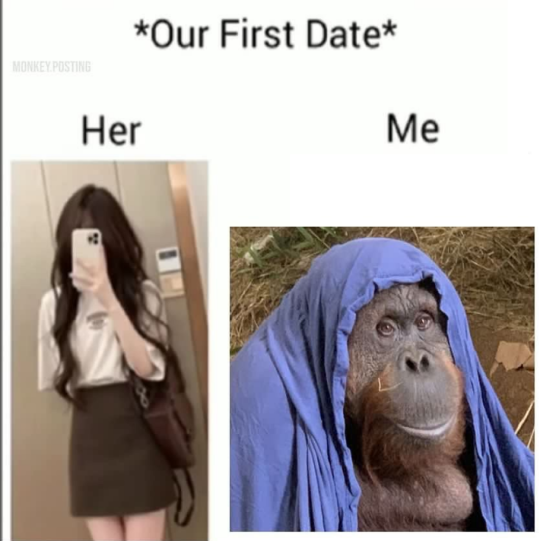
[Image ID: A meme from monkey.posting of 2 photos on a white background with black text. The text reads: “*Our First Date*” With “Her” above a photo of a thin person with long dark hair wearing a white t-shirt and black mini skirt taking a mirror selfie with an iphone and “Me” above a photo of an adult orangutan with a blue blanket draped over its head. End ID]
Memes like this are widely enjoyed and harmless. The primates are engaging in natural behaviours, the pictures in the memes are primarily sourced from the social media accounts of zoos and sanctuaries, and the consumers of the memes are animal lovers. Further from the primate posters of Instagram and Tumblr, other primate pictures are used. These pictures more commonly depict monkeys in baby clothes, in urban settings, being fed by tourists, and grimacing or swatting. The original context for these pictures is lost, and they are reposted with relatable captions, like the image below.
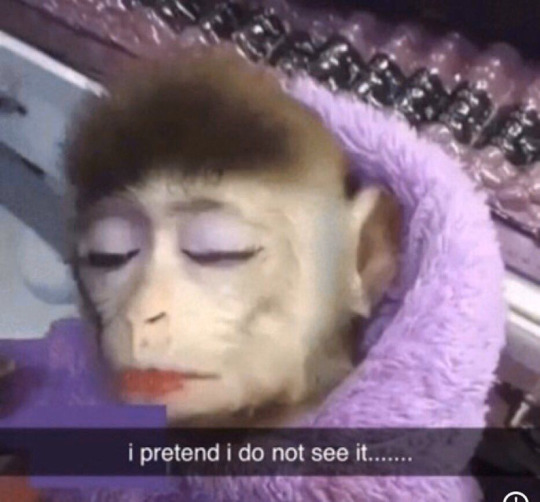
[Image ID: a baby macaque in a fuzzy purple hoodie wearing lipstick, purple eyeshadow, and eyeliner with its eyes closed. The caption is overlayed and reads “i pretend i do not see it.......”. End ID]
What the average person who posts these reaction images sees is a funny picture, and with the rapid rate of posting and viewing the idea of interrogating the background of every meme and image you see online seems exhausting, and ridiculous. However, the one piece of context that connects every image of a primate in baby clothes is that these images all depict animal cruelty. Not only that, but the producers of these images are making money off of animal abuse.
Monkeys are extremely intelligent and have very demanding social, physical, and intellectual needs. No pet primate is living a life that can meet these needs, which would involve massive enclosures with diverse diets, many other monkeys to form relationships with, and daily enrichment. While some pet primate owners try to give their unfortunate and expensive pets the best life they can, on YouTube and other social media sites the algorithm rules and leads to dark places.
A regular viewer of monkey and ape videos will be recommended videos of pet primates at an increasing frequency, with abuse and neglect becoming more and more common. In a BBC article studying the online groups of dedicated “monkey haters“ whom delight in videos depicting the abuse and neglect of monkeys, the algorithmic pipeline towards animal abuse is documented: “Kapetanich saw monkeys dressed up in baby clothes, monkeys being bathed, forced to walk upright or do other unnatural tasks. Then the algorithm served her videos of monkeys being slapped and sprayed with water. These videos violated YouTube’s terms of service, so she reported them, but the platform didn’t seem to take any action." Without ever leaving YouTube or actively searching, a regular person was served videos of baby monkeys being abused. After continued viewership, YouTube recommended a video of baby monkeys being tortured. Most shocking of all, is that the comments on these videos are mostly supportive, with many suggesting torture methods they want to see in future videos. Some monkey haters are willing to pay, and contact pet primate owners who post videos of them scolding or pushing their monkeys with requests for more brutal punishments.
The BBC article is here for those who wish to read, but I warn against those sensitive to disturbing articles to avoid or do so with caution. While my mission stays on social media and the clear web, the article dives into the dark web and encrypted telegram groups where the most extreme animal abusers congregate. My point is not to disturb people, but to educate on how even innocent looking images of dressed up monkeys are the start of a pipeline that leads to animal abuse. In fact, many of the exact same monkeys start their lives as dress up candidates and end their lives before reaching adulthood, as their owners profit off their suffering.
What can you do?
No one likes to think that they are involved, even implicitly, in the suffering of others. Many critiques of reaction images featuring abused animals will be met with dismissals, that “it’s not that deep“. While it is not your fault that animals are being abused if you shared images of dressed-up monkeys online, using these images normalizes the most socially acceptable form of their mistreatment. There are small and simple changes to your online presence you can make to help:
Use reaction images of primates from wildlife photographers, zoogoers, and the social media accounts of high-quality zoos and sanctuaries.
Report images and videos of animal mistreatment you see on social media as animal cruelty.
Contact YouTube and other social media sites such as Instagram and Facebook to tell them that hosting animal abuse videos and images is unacceptable.
You don’t need to be an expert in primate welfare! Avoiding any photos where a primate is clothed is enough to reduce your chances of accidentally using images depicting abuse by a substantial margin. Being mindful, kind, and open to learning goes a long way.
84 notes
·
View notes
Note
Love your blog so much!! I'm wondering, with as many snakes as you have, what does an average day look like to you? How do you start the day, how do you fit in the care for all your snakes, do you have specific chores for specific snakes that have some special need? Thank you!!
I keep a schedule for most things and rotate daily chores to help keep it from becoming overwhelming! So a typical day looks like:
Before work:
Change water and spot-clean as needed (all snakes, takes about an hour)
Prepare food for diurnal snakes Wednesday-Friday (we go in shifts by room; quarantine snakes eat Wednesday, rescue and work snakes eat Thursday, and my pets eat Friday. Again, about an hour)
Record any updates in my log (if anyone shed, who ate, etc.)
Quick check to make sure everyone's thermostats and temperatures look good and there are no obvious issues with anyone
After work:
A more thorough check-in with everyone. This is actually how I unwind after the day, I like saying hi to everyone and making sure everyone looks good. I'll often use this time for brief handling sessions with my pets.
Any needed medical maintenance. Right now I have some rescues who need daily antibiotic injections and a couple more who need minor at-home wound care (things like vet-prescribed ointments). Right now all this takes like an hour but it can take longer, depending on who I've got.
Most days, some training time with ambassadors. Even little things like working on our program hold can help keep their minds active.
Deep enclosure cleans on a rotation. Snake enclosures only need deep-cleaned every couple of months if you're diligent about spot-cleaning, so I've got a system where I do like one or two deep cleans a day. Keeps it from getting overwhelming! As a snake gets their enclosure cleaned, that's when we do things like logging weight changes and having a nice long handling session while I work. I like listening to music while I do this.
Before bed:
Feed nocturnal snakes on the same schedule as diurnal ones. Takes a bit longer because constrictors can take their sweet time
QOL log for sick/elderly snakes. I have a spreadsheet that I use, things like measuring their activity, feeding response, response to enrichment, etc.
Another quick check-in to make sure everyone's perimeters look good and all's normal with everyone.
As you can see, they keep me busy! It's a big time commitment, but the cool thing is that as long as you set up a snake's enclosure correctly and are careful about maintaining your perimeters, there's not a ton of daily maintenance.
112 notes
·
View notes
Text
We come to you today with a heartfelt appeal on behalf of our cherished corvids. Corvid Isle Sanctuary is a small and entirely self-funded non for profit organisation based in the Scottish Highlands. We provide a safe haven for these intelligent and captivating birds, who have faced hardships and adversity. At our sanctuary, we offer a forever home to corvids that have endured unimaginable challenges. Many have suffered injuries, or impairments or have been orphaned, requiring specialised care and attention. We believe in their inherent worth and dedicate ourselves to their well-being, providing a sanctuary where they can flourish and find refuge from a world that often misunderstands them.
Your financial contribution can make a world of difference in the lives of these remarkable birds. Our sanctuary provides a nurturing environment where corvids can thrive. Your support will help us to maintain clean and spacious aviaries and enclosures that meet their specific needs. Each bird in our sanctuary deserves individualised care and attention. Your donations will contribute to their daily nourishment, medical treatments and enrichment activities that enhance their physical and mental well-being.
Some of our residents have arrived at our sanctuary with physical or emotional wounds. Your support will help us rehabilitate these birds allowing them to heal and regain their confidence. We are dedicated to raising awareness about the intelligence, beauty and importance of corvids. Your contribution will help us to maintain our website aimed to foster understanding and appreciation for these incredible birds. Additionally, this will also help us to continue to provide expert advice here in the UK and worldwide.
55 notes
·
View notes
Text
Angel Exterminatus 6

Raven Guard daily affirmations
we've gotten back into the silly zone
also i can't help but think of "hrrrg i'm trying to sneak through the vents but my body is too dummy thicc and my armour too cumbersome and-"
quietbluejay was then shot by a raven guard sniper

not in this universe they ain't
Nykona: I need enrichment in my enclosure. This is why I am sneaking around on the ceiling

aloooone

incredible
sharrowkyn batmanning it up like i am darkness i am the NIGHT
tarsa: oh hai there

tarsa realizes that to talk to nykona you need to break everything down to small manageable phrases
welp
over to the captive Fists again. Life continues to suck for them.
Back to the Iron Hands


ohhh the Drukhari (proto-Drukhari for the pedants) are playing both sides
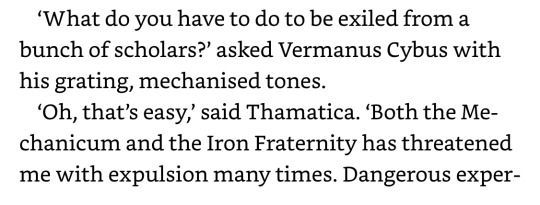

love this guy
explosions and happiness on planet medusa

Sunk cost fallacy? What's that? Is it something you eat? No, that's sand and rocks
oh we're back to kroeger ❤️

i feel like mcneill is perhaps doing a theme here

i've honestly found this character trait of perturabo to be really interesting compared to how I see people talk about him (again I might be missing stuff)
(i know a lot of it is memeing but you can meme on chocolate eclair backbone as well!)
and yet it's absolutely a core character trait (at least in this book. who knows how he will be written elsewhere)
perturabo lacks initiative
he does not move unless moved upon
he has pie in the sky dreams, but no real ambitions and concrete goals he is willing and able to work towards, no grand strategy
this makes it entirely unsurprising that he was basically chilling in the eye of terror for ten thousand years
it also makes it unsurprising that his move when he had enough was to just...pack up and nope out
there's stuff he wants, but never enough to make a stand and go for it, or to say no.
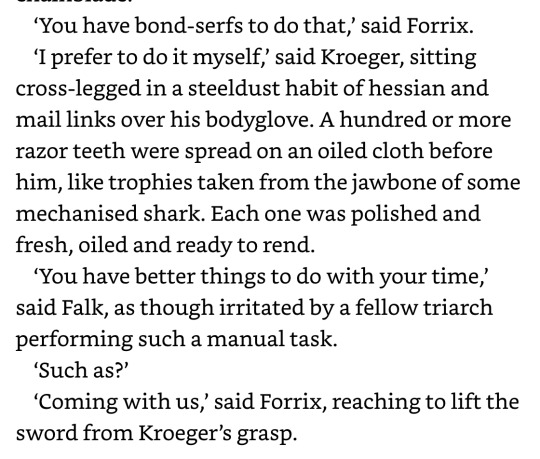
i am feeling the teenager vibe in this iron warriors ship tonight
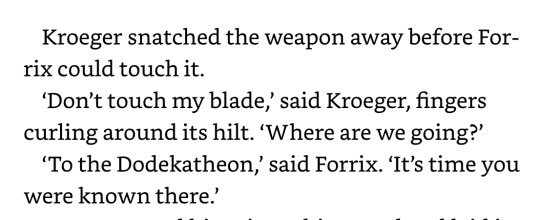
you're part of the team now kroeger you gotta go drinking with them

My goodness they're worse than the Thousand Sons

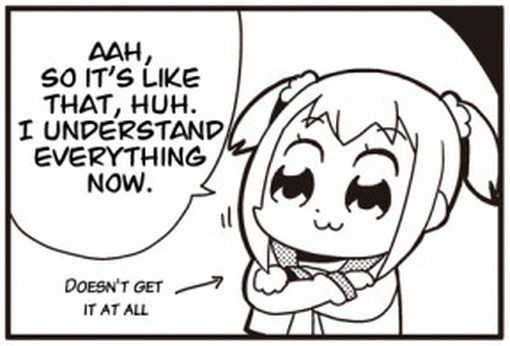
actually, this is basically Kroeger at all times

I like him already
OH ITS THEIR WARGAMING ROOM
Kroeger (local jock) got bullied by the nerds to come down and play 40k
yes. this is funny to me.

just watch i bet it was Soulaka who designed it
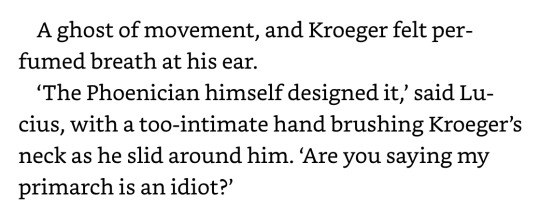
oh
nvm
Kroeger: can I get a restraining order
Lucius: restraints you say
fortunately for Kroeger his sempais are here to back him up


bruh???
since, uh, when, exactly, did imperial forces care about targeting the civilian population
i mean in terms of "we shouldn't do it"
man this really is peak wargaming
and somehow perturabo and his combat robots manage to jumpscare them
so much for astartes senses
so they're trying to figure out how to do the siege of terra and their "vaunted" tactical prowess is…human wave tactics
"it's basically impossible"
kroeger: nah, I'd win
perturabo, showing up out of nowhere:
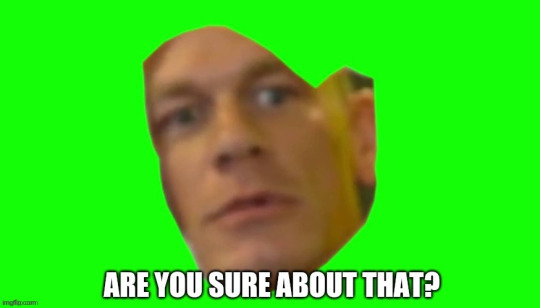
Kroeger: yep


owo


there's a lot going on here
one, this is the big flaw of a lot of the most well-meaning people in the 30k Imperium (the "oh we'll just fix everything after we're done with all the conquests")
this works really well as a metaphor for that
the second is how it ties into Perturabo's attitude about guilt
Perturabo is unable or unwilling to make the leap from "a thing once broken will always be broken" to "a thing once broken will always have been broken, but does not always need to remain a broken thing"
...
he doesn't know how to recover from mistakes
he's basically got gifted kid syndrome turned up to 11 because he woke up with like an entire library of technical knowledge in his brain but no life skills
this is why he has all those designs and never builds them and can never be satisfied with all the little quirks that real life introduces to a design
#warhammer 40k#bluejay reads warhammer#perturabo#there's enough character analysis here i think so i'm tagging him
7 notes
·
View notes
Text
TIKTOK SENTENCE STARTERS PART 6
some of these are quotes from tiktok creators, and some are from various other forms of media that were popular audios/trends on tiktok
❛ Guess who didn’t eat me out last night? ❜
❛ I don’t know if I’m on my period, if there’s a star out in the sky that moved too far to the left, or if my brain chemicals just went ‘uuggghhhh’, but I’m sensitive and violent right now ❜
❛ ‘Ugh, why are you girls always going to Target?’ Ta get stuff. Duh. ❜
❛ Don’t act like you’re above wearing a cowboy hat for a tiktok. Oh! Handsome cowboy! Handsome cowboy! ❜
❛ How fucking elaborate do we have to make this fight?? Get down here!! ❜
❛ It continues to redefine ‘family’ as meaning: ‘some dudes who ate at my house’, instead of people you share a bloodline with. ❜
❛ What’s more American in this nation of living paycheck to paycheck than living your life a quarter mile at a time? ❜
❛ You’re gonna fuck the bee?!?! ❜
❛ I need a trenta cup of heavy cream. ❜
❛ If there’s one thing about me, it’s that I’m gonna dilly dally. I am a dilly dally-er. ❜
❛ You’re taller! How fucking dare you. ❜
❛ Santa sent his deer to fuck your shit up cause you’re on the naughty list. ❜
❛ How many times do I have to tell you mind control doesn’t work on me? ❜
❛ I have never seen a creature look more like a rotisserie chicken, and I am including every rotisserie chicken I’ve ever seen. ❜
❛ You can actually have two loving and supportive parents and still end up weird and unstable. ❜
❛ Blaming it all on my father really takes away all the work that I put into making me the worst version of myself. ❜
❛ I want my mom to come home but if I call her and say “mom I convinced myself that the dog is a shapeshifter again.” she’s going to think I’m crazy. I’m not crazy! ❜
❛ Kill me or come cuddle with me, 'cause you’re freaking me the fuck out. ❜
❛ I mean these days I just be wondering like, will I ever feel fergalicious again or is it just over? ❜
❛ If I go missing please do two things: one - check near the parking lot of Sears, two - arrest Billy Ray Cyrus. ❜
❛ Daily affirmation, repeat after me: I am not the bigger person. I am the smaller person, who is prone to pyromania. ❜
❛ Why are they playing Shrek songs in church? ❜
❛ She gave me trauma beyond human comprehension. ❜
❛ Girl if you don’t get your coochie sticks out of the uranium bin… ❜
❛ The children yearn for the mines. ❜
❛ Alright here’s a lesson in physics… that’s not how physics works. What the fuck just happened?! ❜
❛ Run like you’re being chased by the love of your life but you’re not ready to love him yet, you still got some learning to do! You have to love yourself first! ❜
❛ Hate me or don’t hate me, but if you put holy water into a humidifier you won’t have a vampire problem. ❜
❛ Awwwww shit. You don’t know about doing whatever the fuck you want? Damn. I’m sorry. Hope you find that someday. ❜
❛ Shh! Don’t bother me, I’m having enrichment time in my enclosure. ❜
❛ Quite frankly, I don’t care where you taking us, cause anyone with an ass like that gotta be blessed and highly favored. So why wouldn’t I follow gods child? ❜
❛ What the fuck did Dora say? Where are we going? To follow that ass! ❜
#rp meme#sentence starters#sentence meme#inbox meme#ask meme#rp prompt#roleplay meme#roleplay prompts#*tiktok
66 notes
·
View notes
Note
Just curious, how do you find time to care adequately for 50+ animals? Not insinuating you’re not caring for them correctly or anything. I understand that reptiles and rodents don’t need much if any 1on1 enrichment time with you, and some reptiles have infrequent feedings. But that’s gotta be at least like 30 tanks/cages to maintain, do you ever get free time between work and pets/fosters??
Short answer is I don’t get very much free time and I’m in hell
Long answer is a lot of spreadsheets and to do lists and frustration and I am often a day or two behind on at least one thing that isn’t super time sensitive. Especially right now with the foster rats getting medicated 2x a day.
My current routine is: Wake up, medicate rats, check everyone’s water sources, go to work.
After work if I have any intakes scheduled I do those- I am currently at capacity at my home but I still pick up new intakes and deliver them to their foster homes. Then I go home, feed the rodents, feed the reptiles if needed, water enclosures as needed, check water sources again, medicate the rats.
I give the small rodents (gerbils, hams, and mice) enough food for the week every Sunday so only the rats get fed on a daily schedule but I do give treats, fruits and vegetables, etc a few times throughout the week. I also do visual checks on everyone who is out and about and dig around for anyone I haven’t seen in a few days.
Right now the baby rats get their cages cleaned 2-3x a week because they’re so messy but the adults get cleaned 1x a week. My mice get cleaned 1x a week. Gerbils every other week and hamsters 1x a month and really only their pee spots. I spot clean throughout the week, this just refers to major cage cleans (usually between 1/4 and 1/3 of the bedding)
My permanent rats are on the Shunamite Diet so I meal prep their fresh meals every 2-3 weeks and make enough to last me for a while. I freeze whatever won’t be used within the week. They get fresh meals 2x a week and dry meals the rest of the week. The fosters are on Oxbow and Science Selective pellets.
Niobe (ball python) gets fed 1x a month, Ricearoni (hoggie) 1x a week. Freak, Meryt, and Lucky (pacman frog, axolotl, and leopard gecko) get fed 2-3x a week. The house geckos get fed 3-4x a week and luckily my girlfriend works at a pet store so usually she just brings me home feeders and I drop them in that day.
Most days it isn’t all that much maintenance but it is a LOT of different little things that all add up. For things I know I need to do but feel no motivation for, I’ll often make an instagram reel about it to basically force myself into doing it- same reason why I post my to do lists on here and check them off where people can see.
And I am very lucky that my friends & partner are understanding of the fact that sometimes I have to make last minute changes to plans because the pets need something that I can’t put off and oftentimes are happy to just accompany me on errands and chat while I clean cages instead of like, going out.
14 notes
·
View notes
Text
Self care asks because I think some people might need to be put on the spot to get them to do it
1. Just guess, doesn’t have to be completely accurate; about how much water have you had today?
2. Be honest, what does your screen time look like?
3. Where on your face are you currently breaking out? What does that area tell you, and what do you need to do to fix that?
4. How late did you stay up last night?
5. How late did you sleep in this morning?
6. How close to your usual bedtime do you have your dinner?
7. Who was the last loved one you spoke to and when was that?
8. In fact, who was the last person you interacted with irl and when was that?
9. You do brush your teeth at least twice daily, right?
10. How often are you showering these days?
11. Pick something—big or small—to be grateful happened today.
12. What’s the last work/school related thing you successfully completed without procrastinating?
13. What’s the last NON work/school related thing you successfully completed without procrastinating?
14. Does the tiger have enrichment in its enclosure? What does it consist of (that isn’t a screen)?
15. How clean is your living situation right now?
16. What’s the last thing that made you happy, that you didn’t have to pay money for? What else can you do that with?
17. What’s the last thing you did that made you feel super accomplished?
18. Do you have any visible goals you’ve set for yourself? Doesn’t matter what they’re relevant to, what are they?
19. Making sure your responsibilities are taken care of are also important in caring for oneself. Are you staying on track? What’s keeping you from falling off the curve? Or, what’s making you fall off the curve?
#I’m curious#I’ve never seen an ask game like this so I thought it’ll be nice to make one#and possibly benefit the girlies who won’t do these things unless promoted by another person#yeah I see you bitches#ask games#lune’s thoughts
1 note
·
View note
Text
2/23
It’s starting to thaw out where I am; I saw snowdrops on Wednesday when I was walking to the train station. I don't know what it is about February that makes me need to listen to Maisie Peters' entire discography, but that's what I'm doing today. I had strep throat at the beginning of the month and it kind of get me into the habit of being a hermit who spends too much time in bed watching old seasons of Survivor, and as it turns out that is bad for the ol’ brain! I’m trying to get better at exploring the city, since I’m only staying here for a couple months, and I don’t want my only memories of this spring to be sitting on the couch mindlessly scrolling. This weekend I’ve got three dates, so that’ll get me out of the apartment in the evenings at least, and my plan for next week is to start giving myself daily “quests” of going out to a new neighborhood/park/wherever when I have free time—I think it’ll be a good balance between being A Structured Activity and An Adventure. More enrichment for my enclosure! I’m also going to try and post on here more regularly bc I kind of miss when I was in school and would do my little studyblr updates.
0 notes
Text
Remember These 5+ Water Tank Vastu Tips For Your House Placement.

Vastu for the water tank is placed in homes to ensure that water flows freely and smoothly throughout the house. They are a vital part of any building or home.
The water is pumped into the tank from wells or businesses for daily duties.
These water tanks are connected to outer supply tubes that bring water to the dwellings from municipal companies.
Water tank systems are an excellent architectural addition that has helped people collect water for drinking, irrigation, livestock, and other uses.
Water has long been seen as a blessing that assures good health and enriches life with joy, goodwill, and pleasure.
Vastu Shastra emphasises the need to situate both the underground and the overhead tanks in the proper location to maintain a healthy and calm water flow in the home.
Suppose the water tank is situated according to Vastu Shastra guidelines. In that case, it will bring more luck, peace, and prosperity.
This blog will provide a valuable guide to some of your home’s essential water tank tips.

Water is also quite crucial in vastu shastra. It is one of the five elements of Panchtatva- air, fire, earth, and space are the other four elements.
When these five elements are placed according to vastu norms, the house remains balanced and provides various benefits to the occupants.
In contrast, if they are put at random, the balance is thrown off, resulting in many problems.
As a result, it is vital to ensure that the water tanks are placed according to vastu. Aside from this, the proper location of other house areas that store or channel water, such as the kitchen and bathroom, is also critical.
Two types of water tanks are commonly seen in homes: underground water tanks and overhead water tanks. You can readily tell the difference because their names are self-explanatory.
Most people incorrectly assume that their placement positions must be identical because they are both natural water storage tanks. However, according to vastu specialists, this is not the case.
Though they both primarily contain water, the nature of their enclosures differs. The underground water tank represents the water element, while the vastu for overhead water tank represents the element of earth.
As a result, their vastu placements are considerably varied.

The underground water tank in the house is installed beneath the ground by drilling a hole within the home’s boundary.
An electric pump is required to get water to the surface for further use.
They are great for those who want to conceal their water storage tank or live in areas where the weather can damage them.
Because the material and vastu placement of the underground water tank cannot be changed in the future, it is much more critical.
Vastu For Water Tank Underground In North Zone
North, northeast, and northwest represent the water element from the eight directions described above.
Therefore, according to standard vastu shastra guidelines, locating the underground water tank in a house in one of these zones is advisable.
Since they are made of the same material, they mix seamlessly and give homeowners several advantages.
Many people who need to be more knowledgeable about water tanks incorrectly position both types of tanks in the northern zones, unintentionally causing severe problems for themselves and their families.
However, acquiring additional advice from a qualified vastu specialist is essential before establishing an underground water tank in the northeast.
Vastu For Water Tank Underground In East Zone
If the north zones are not an option for your plot, consider using the east zones instead. It is an ideal water tank vastu for the east-facing house.
People whose occupations revolve around client connections are advised to position their water tanks in the east zone according to water tank vastu since it can increase their social circle.
Vastu For Water Tank Underground In West Zone
Despite the widespread misconception that it is a vastu flaw, placing an underground water tank in the west is also good.
It offers many profit opportunities, making it a wise choice for business owners. The underground water tank size, as per vastu, should also be considered.
Vastu For Water Tank Underground In South Zone
The south zone should not contain an underground water tank in the house. Because it conflicts with the vastu of the water tank, it is a severe vastu fault, and vastu experts advise removing it as soon as possible.
It can result in accidental injuries, financial strain, and missed opportunities if retained in the southeast zone.
Keeping in the southwest zone might cause heart problems, strain relationships, and make it more challenging to take advantage of life’s opportunities.
If an underground water tank is placed precisely to the south, it may be a barrier to service members’ advancement, fame, and promotion.

Below are some of the primary vastu tips for underground water tanks, which need to be considered for a successful and happy life.
The ideal zone of the underground water tank in a house is the North, North North East, and North North West. A water tank placement in these zones will provide new opportunities, strengthen bonds with your partner, and boost immunity.
It is strictly advised to avoid underground water tanks in the fire zones. Avoid its construction from East South East to South direction. You may witness frequent financial losses, and fire breakdown in the premises happens if a water boring underground water tank is present in the fire zone.
Furthermore, underground water tanks are not permitted in the South-South West and West-South-West directions. If you have an underground water tank in this zone, it will lead to disturbances in your education and savings.
If your underground water tank is in fire zones, the best vastu remedy is to paint the tank’s lid green.
If your water tank is in the South West direction, it is highly advised to remove it immediately. If not paid attention, it will lead to disastrous effects such as the death of male family members, financial crisis, instability in the family, and no overall growth of your family.
Getting water tank vastu done with the best vastu consultant for a prosperous and healthy life is essential to keep yourself safe from these disastrous effects.

Overhead tanks are commonly found on the roof of a structure, making them subject to rain, heat, snow, and other unavoidable conditions.
According to Vastu Shastra, keeping the tanks covered is best.
They are perfect for a more cost-effective solution with easy installation and maintenance.
Moving these tanks is time-consuming but possible in the event of a significant vastu fault.
Vastu For Water Tank Overhead In South-West Zone
In the overhead water tank in a southwest direction, yellow is the best colour to use. Grey and white are other options you can go for.
It is best to avoid blue, green, black, and brown. Orange and red are also not recommended.
Vastu For Water Tank Overhead In West Direction
In the west direction, white, grey, and yellow are the most highly advised colours, according to vastu shastra. Colours like black and blue can also be considered.
However, Avoid using red, orange, green, and brown colours in this zone.
Vastu For Water Tank Overhead In South Direction
The best colours to choose in the south direction are yellow, red, and orange. Colours like green and brown might also be appropriately considered.
Try to avoid using the colours white, grey, blue, and black.
Vastu For Water Tank Overhead In North Zone
Avoid all north zones for the vastu for the overhead water tank. The same in these directions can result in serious health problems and monetary losses.

Below are some of the primary tips for vastu for an overhead water tank that needs to be considered for a successful and happy life.
According to Vastu Shastra, an overhead water tank should be placed on the building’s west or southwest side.
It’s best to avoid the North-East corner because it has to be the lightest portion of the house, and keeping the tank there produces an energy imbalance.
Even the South-East and northeast corners are acceptable, as long as the building is big and tall enough, and the appropriate direction is south.
Avoid all north zones for the vastu for the overhead water tank. Placing the same in these directions can result in serious health problems and financial loss.
It is always best to position the tank at least two feet above the floor; this allows for better water pressure flow.
The tank should not be in direct contact with the roof slab because this might generate humidity in the building, causing walls and other floors beneath the roof to rot.
According to Vastu Shastra, light-coloured tanks with horizontal lines are always beneficial. The reason is to avoid fungus and make it easier to discover any problem, such as leakage, and protect it from damage.
A water tank should never be placed above your bedroom, main entrance, or kitchen. This can lead to health and financial issues.

If you own a plot and want to build a house, you can easily ensure that your water tank is in the ideal location.
However, doing this can be difficult if you live in a rental home or have acquired an apartment.
You cannot make any changes to your apartment without the owners’ approval, nor can you build a separate overhead water tank for your property.
As a result, you have little choice but to live with vastu flaws in your water tank, which can harm you and your family.
It is essential to consult a vastu consultant in these situations and explain your options. They may offer vastu advice to help restore balance or mitigate the negative consequences of the vastu doshas.
They may propose placing specific vastu items in a particular location. To learn more about vastu, you’ll need a one-to-one appointment.
Conclusion — Vastu For Water Tank
At Panch Vastu, we provide Water tank vastu and other services related to other parts of vastu shastra for both residential and commercial premises.
So, contact Abhishek Bansall, our vastu consultant, and let him assist you in transforming your life and leading a happy and prosperous life ahead.
He holds a profound experience of 15+ years in vastu shastra and has the expert knowledge to bring financial growth, profit, and harmony to your life.
For further information, visit our website.
#panchvastu#vastutips#vastu tips#vastu shastra#vastu#vastuconsultant#vastushastra#business#spirituality#vastu for house#vastuexpert#vastu for home#vasturemedies#vastu for office#residential architects#architect#builders#interior designer#real estate#vastuforfactory#vastu consultant#vastu dosh#industrial vastu consultant noida#vastu for business#vastu for money#vastuforwealth#vastuconsultation#vastuforbusienss
0 notes
Text
Common misconceptions surrounding the care of monsters
Contrary to popular belief, it is NOT normal for a Cerberus’s heads to fight with one another; this indicates anxiety or lack of proper enrichment.
Giant spiders are actually very social creatures, and should not be housed alone.
Provide your Sphinx with enrichment by answering its riddles. Though Sphinxes can be trained to attack those who answer incorrectly, they actually normally speak in riddles as a form of social play that is essential to their development and well-being.
If you cannot provide brimstone and a large pool of lava for bathing, don’t purchase a Hellhound! They are animals with very specific care needs and their health will suffer if they are not given the proper habitat. Likewise, most Hellhound kibble brands on the market do not meet the recommended daily requirement of damned souls for Hellhounds. Always check the labels!
The practice of putting blinders over the eyes of Basilisks to make them less dangerous is cruel. Basilisks should not be kept in enclosures where people other than expert caretakers normally come into view.
Many hippocampi enjoy pulling sea chariots, boats or inflatable floats and it can be a good source of enrichment and exercise. Make this activity fun for your hippocampus by rewarding it with treats such as fish and allowing it to participate as it wants to.
A labyrinth is NOT an appropriate habitat for a Minotaur!! Minotaurs need fresh grass and shade to lie down in to be happy. Also, a diet of only human flesh will cause malnutrition. Supplement your Minotaur’s diet of kidnapped youths with a source of fiber, such as hay!
Remember, that hatchling Roc is an adorable fluff ball now, but it will eventually become a fearsome elephant-sized bird of prey with a ravenous appetite and very demanding housing requirements. A pet should always be a well-researched commitment, not an impulsive decision.
While going into the wild and gaining a dragon’s trust is often romanticized, there are many dragons in search of a loving family much closer to home! Try looking into dragon rescue organizations near you.
Some Manticores need to be fed live prey; others, however, will accept prey that has been frozen and thawed. It depends on the individual.
Even smaller species of griffin need a lot of space. Domestic rock-griffins, though only the size of a cat, need room to fly and to build large nests. If you live in an apartment, it is better to adopt one of the smallest species, such as one of many types of song-griffins! Humming-griffins, however, though you may have seen cute videos on Instagram, should be avoided because they are not domesticated and their wild populations are endangered by the pet trade. It is best to admire their iridescent feathers in visits to accredited conservation organizations!
#creatures#monsters#fantasy creatures#dragons#griffins#cerberus#roc#manticore#griffin#dragon#fantasy monsters#sphinx#basilisk#fantasy worlds#fantasy worldbuilding#10k#5k#15k
20K notes
·
View notes
Note
I've heard a few things about some primates, or any wild animal in zoo care really- can bond with their caretakers? Do primates see care takers like subordinates since they bring them their food, or do they see them like a friend or something similar? Do primates make friends with one another? I've heard that some kinda live in "packs"... would they see their caretaker as part of that??
(This is a weirder one but since the topic of primates having. fascinations for certain objects..) Can a primate get the wrong impression-?? and think of a caretaker as a possible mate or something?
Hearing about human bonds with animals, particularly wild ones, is so interesting to me. Because like of course this can't happen naturally in the wild (or at least, shouldn't since its best we leave wildlife alone) and since it's in a professional setting it must be a unique one right?
Also you mentioned having a social time with a lemur- how does that work?? This is all so interesting to me!
So, this is a little complicated. When an ex pet comes to a sanctuary we do all we can to encourage social behaviors with their species. Typically, they'll he housed nearby to watch and learn the body language and vocalizations, if they seem interested they're allowed single finger contact through a mesh or screen door, then we attempt an introduction.
Some animals never express interest in their species, and instead show interest only in humans. When this is the case, we attempt videos of monkeys or anything the animal may be interested in. If this doesn't satisfy their social needs (typically doesn't) then we do one-on-one daily social time along with extra enrichment because living alone gets extra boring for social species and animal who were used to alot of human interaction that now get little may express troubling and self harming behaviors.
The general rule is we don't initiate contact with an animal. If they're reaching out, asking for physical attention from caregivers we might groom them with a stick or back scratcher, do interactive enrichment like extra training, mutual foraging (sitting by the enclosure and picking at grass and the money will do the same), music, bubbles, playing in water from a hose or pool. Anything the animal seems interested in to keep them happy and entertained!
For animals that are safe to physically interact with, caregivers may do so in protected contact (through mesh/fencing) and groom by hand or allow the monkey to groom them. Physical interaction is a last resort to satisfy their social needs and we usually try to wean them off human attention and get them to eventually express interest in other primates but unfortunately for animals who were taken from their mothers young and never allowed to express their natural behaviors- they may never learn how to be a monkey and may always rely on human attention to meet their needs.
105 notes
·
View notes
Text
Blue-breasted quail (AKA button quail) care sheet
Excalfactoria chinensis, AKA Chinese painted quail, king quail, etc., (not to be confused with hemipode buttonquail, which are actually a group of strange and tiny shorebirds!) These little guys are the smallest species of true quail, which are part of the pheasant family, and can live a little over 4 years under proper human care. Full-sized adults are no larger than a standard day-old chicken:
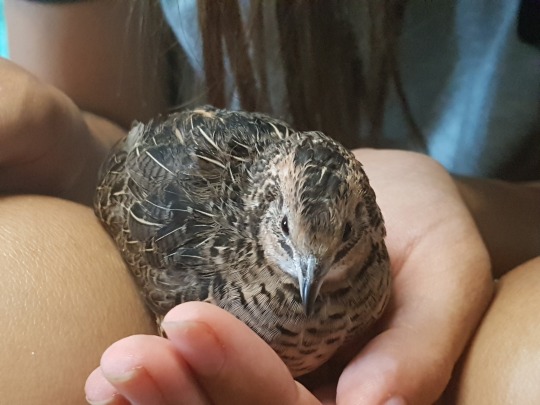
(Photo: mine)
Diet:
Two thirds of a daily adult blue-breasted quail ration should be fresh game bird pellet (they can learn to eat whole pellets, but ideally these should be ground/broken up into smaller pieces) or chick starter crumble. The remaining third should consist of fresh, bird-safe fruits and vegetables (mine personally prefer Romaine lettuce and grapes), supplemented with extra sources of protein such as live mealworms and boiled egg during periods of heavy molting or egg-laying. Any uneaten food items should be removed well before they get a chance to spoil/rot - quail are messy eaters and will scatter food about and kick bedding/waste material all over it, even if it is given in an elevated food bowl. Grit must be supplemented as well, in addition to calcium for laying hens. Most hens actually do well with a cuttlebone to peck at (it sounds like they’re playing a tiny xylophone and it’s probably one of my favorite things ever). As with any other bird, fresh water should be provided and changed daily. It can be offered in a shallow bowl with marbles/pebbles at the bottom to prevent drowning; alternatively, quail can be trained to drink from hamster-style water bottles.
Housing:
To minimize physiological and psychological stress, a quail enclosure should be placed away from anywhere it could be exposed to extreme or fluctuating temperatures, high-traffic areas, or perceived predators such as dogs and cats. The more space, the better - I would personally recommend at least 3 square meters or 10 cubic feet for a pair or trio. Their behaviour will indicate whether they’ve got enough space AND hiding places. If they spend the majority of their time repetitively walking/running along the edges of the enclosure, something needs to change, and if abnormal feather-pecking behaviour develops (more on that below), then they definitely do not have enough space. Blue-breasted quail will burst into flight when frightened (or do a shorter sort of flutter when they simply want to exercise their wings), and while they can reach impressive heights, they are pretty terrible at controlling which direction they go. They will be able to overshoot the walls of any enclosure you try to put them in, so a lid/cover is a must, and it needs to be soft enough or lined with soft material underneath to prevent head trauma when they inevitably hit their heads on it. Cleaning and disinfection of the entire enclosure with bird-safe agents needs to be done regularly, how frequently depends on many factors such as stocking density and the type of litter/bedding being used. Wood shavings/pellets, shredded paper, chopped straw, newspaper/paper towel (with small areas of substrate they can dig and forage around in) all work well, but the best enclosures will offer a variety of substrates to provide the quail with lots of choice as to where they can perform specific behaviours. Which leads nicely into the next segment...
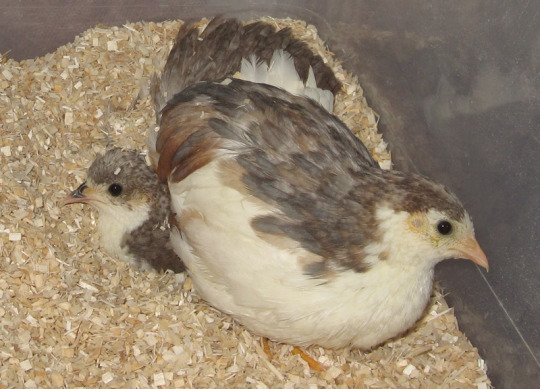
(Photo: floridabuttonquail.wordpress.com)
Enrichment:
Quail *love* to dust-bathe. Chinchilla dust or sand are ideal for helping them get excess oil off their feathers, but they will bathe in other substrates as well, such as wood shavings, dried moss, etc. Small toys, when introduced carefully and with some treats scattered on or around them, will also stimulate these curious little birds. I give mine tiny whiffle balls stuffed with dried mealworms to encourage foraging behaviour. Furniture for the enclosure can include things like natural or artificial branches/twigs, leaves, and lots of small rock caves and plant pots for hiding places as well. Like any other pet, quail can be trained using positive reinforcement! Here are a couple videos of mine being target-trained. This can easily be extended to teach them to spin on cue, run obstacle courses, and much more! Lack of mental stimulation in quail can lead to abnormal feather-pecking behaviour, in which one or more quail begin to focus their activities on actively chasing their flockmates, then pulling out and eating their feathers. This can easily be prevented by providing plenty of environmental enrichment as described above, as well as appropriate social enrichment - quail absolutely should not be kept alone, and blue-breasted quail in particular do best in male-female pairs or one-male-two-female trios.
General Health:
A healthy blue-breasted quail will spend most of its day foraging and eating, as well as dust-bathing, napping, and gently preening itself and its mate. A quail with healthy plumage who is not molting should basically just be an orb when its feathers are smooth and fluffed out comfortably. Its eyes, nares, and cloaca should be free of discharge, and its beak and toenails kept at a proper length with the help of an appropriate foraging substrate and accessories such as cuttlebones. When they do grow too long, they should be trimmed by a veterinary professional or someone with extensive experience caring for quail (beaks especially should not be trimmed by someone other than an avian veterinarian as there is huge potential for error leading to beak deformities). Despite their small size and often cheap price, quail need and deserve proper veterinary care just as much as any parrot or other pet bird. Please take your quail to a licensed avian veterinarian if you notice any of the following signs: abnormal lumps on face/feet, plucked or consistently soiled feathers, lethargy, difficulty breathing, abnormal feces/urate, lameness, any discharge or swelling, excessive preening or scratching, and loss of appetite, among others.
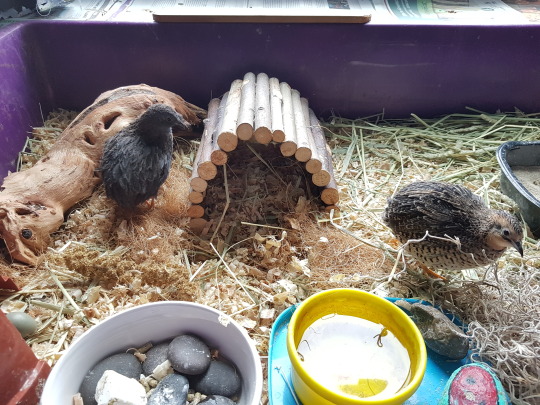
(Photo: mine)
This care sheet was requested by @eclectus-mom! It just occurred to me that this is the first care sheet I’ve ever written, and I just know I missed a ton of points so please feel free to add them on if you are experienced with quail care! And my ask box if always open for other requests and questions :)
#quail#buttonquail#bird#pets#pet bird#birds#husbandry#veterinary medicine#animal welfare#animal behavior#animal training#vet#Blue-breasted Quail#king quail#original post
97 notes
·
View notes
Text
really need people to stop thinking of public policy in terms of how to control a citizenry and start thinking of it in terms of fuckin zoo enclosures. “these are the rules for building a human enclosure where the resident humans live happy, healthy lives and are allowed to express natural behaviors.”
these are the requirements for a Very Good Human Enclosure:
-culturally and nutritionally appropriate food
-culturally and socially appropriate shelter
-lots of social time
-lots of access to Supplies To Make Stuff.
-chores/daily tasks to provide enrichment through productive and meaningful contributions to the enclosure adding up to no more than 12-24 hours per week
the enclosure is a city. make sure every human in the city has all of these things and suddenly, the majority of the humans in the city will become extremely peaceable and collaborative. nudge policies this, economic incentives that. they’re all excuses to avoid challenging the real fundamental problem: inequity. humans want to work and build and make art and talk a lot. if you say every human in the group has the right to do that, that is what humans naturally Just Start Doing. the only thing that stops humans from doing so is when they literally are not allowed because they’re being exploited in some capacity and their suffering begets benefit to someone else.
at this point, I would honestly like to give up on public policy as a whole and put zookeepers in charge of everything. they seem to have a solid grasp on physical needs + natural behaviors, unlike policy heads who clearly don’t based on the everything they say
2 notes
·
View notes
Text
Meet Our Animal Husbandry Team
by Leslie Wilson
Each year, animal care professionals from zoos, aquariums and yes, sometimes even museums, across the country celebrate National Zookeepers Week. What exactly is a “zookeeper?”
A zookeeper is a person who provides highly specialized care to animals. Did you know that Carnegie Museum of Natural History (CMNH) has a living collection that includes 15 animal ambassadors, representing 12 species from all over the world? At Carnegie Museum of Natural History, we have a team of five “animal husbandry specialists” that perform the day-to-day care for the collection. Zookeepers go by a range of titles at different organizations; here at CMNH, “animal husbandry specialist” is what fits our team best.
Animals need highly specialized care every day of the year. Even when the museum is closed. Even on holidays. Even during a pandemic. As animal husbandry specialists, we provide loving and high-quality care to the living collection every single day of the year. Daily feedings, habitat cleaning, behavioral observation, enrichment, training, and record keeping are all part of hard day’s work for an animal husbandry specialist. Animal husbandry specialists have deep rapport and strong, trusting relationships with the animals in our care. From any animal ambassador’s first day at CMNH to their last days on this earth, the animal husbandry staff support each unique ambassador through all stages of life, including the final step of saying good-bye, which to most, is the hardest part about working with animals. Being a “zookeeper” requires emotional fitness in addition to physical fitness; both are necessary for a happy, healthy “zookeeper.”
It’s not all poop-scooping, though! “Zookeepers” do SO MUCH MORE than “clean up” after animals. Another large area of focus for "zookeepers” is education. Every member of the CMNH animal husbandry team works directly with our audiences to share the rich natural history and unique personalities of our animal ambassadors. Creating empathy for the plight of wild animals in wild spaces, animal ambassadors are a powerful force in helping the museum achieve its mission of advocating for a sustainable future.
Animal Husbandry During a Global Pandemic
The last year presented unique challenges, including caring for the animals during CMNH’s Covid-related closures and adapting programs for social distancing and virtual environments once we re-opened. Team members found new ways to support each other and the animals through the disruption of our normal routines and designed creative new enrichment opportunities to make sure that every animal was (and is) healthy and happy. Meet the CMNH animal husbandry team below and learn how they've risen to the challenges of the last year!
Each team member was asked: “How did you improvise, adapt, persist: Keep on keepin’ on?”

Meet Jo, the collection’s registrar! As the registrar, Jo is responsible for maintaining all records for the animals. Jo also is a frequent host of our weekly virtual Live Animal Encounters.
“The challenge for me was supporting the team, both human and animal, while being unable to be there in person. Transitioning animal programming to a virtual space was a unique challenge that afforded me the ability to still be present for our ambassador animals, support the humans on the husbandry team, and keep our audience engaged. I also found ways to guide my coworkers through animal husbandry challenges from home, connecting virtually to troubleshoot minor medical issues and enclosure overhauls.”

Meet Jess, the lead animal husbandry specialist! Jess is responsible for managing animal-related inventory, training husbandry staff and crafting animal enrichment for our sun conure, Mango. Jess often presents the animals from the museum during Wild Wednesdays: Virtual Live Animal Encounters.
“Being away from the animals and other staff members was a struggle, especially in the beginning of our closure. It was hard to go from seeing the animals and staff who cared for them every day to not being able to offer direct support or guidance. One way I wanted to help boost morale in the beginning was to create coloring sheets to cheer up our staff members who were missing the animals. I drew our animal ambassadors in funny scenarios including our coati cooking or painting like Bob Ross; our sun conure flying as an astronaut in space; our pied crow dressed up as his Game of Thrones namesake, Jon Snow. I feel that I’ve been given a great opportunity not only to learn more about animal education and how I can better myself in this field, but also to connect with the animal husbandry staff who are dedicated to providing our animal ambassadors with unique life experiences and exceptional care.”

Meet Aaron, an animal husbandry specialist! Aaron plays a role in ambassador training, particularly with the birds in the collection. He also is great at building fun toys or furniture items for many of the animals, often from recycled materials, including expired fire hoses.
“I was fortunate to be one of the animal care team members to share in the daily care of our animal ambassadors during the museum closures. I relied a lot on the experience and skill of my human coworkers as I learned on-the-go. While the job was often difficult and dirty (at times literally poopy), I feel grateful that I had the opportunity to get to know my furry, scaly, and feathery coworkers more intimately. I still have a lot to learn about our animal ambassadors as we train and educate together. We're constantly working to build trust and confidence in our relationships.”
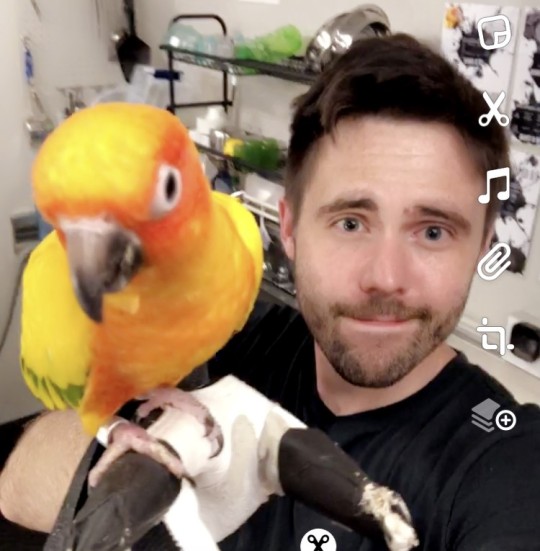
Meet John, an animal husbandry specialist! John serves as an animal husbandry specialist in addition to his role of managing CMNH’s outreach programming. Many of the outreach programs incorporate live animal ambassadors, so this is a perfect match!
“Before the pandemic, my primary relationship with our animals was through programming, and I did more teaching with our animals than I did animal care. Due to COVID, I started to focus more on animal husbandry. Learning to better care for the day-to-day needs of our Living Collection has 100% made me a better teacher. I have a stronger relationship with our birds, I understand the needs and mannerisms of our mammals better, and I've been able to answer questions about our reptiles that I just plain didn't know the answers to before!”
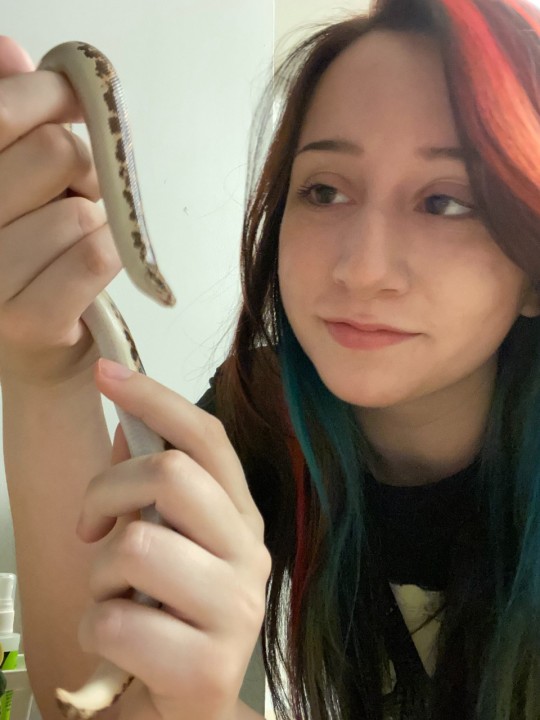
Meet Emma, an animal husbandry specialist! Emma is our newest animal husbandry specialist on our team. Emma works closely with Jon Snow, the African pied crow. Sometimes, it’s hard to tell the difference between their voices!
“The last year has been full of challenges when it comes to making sure that every animal here at the museum is getting the best possible care while also ensuring that we are following correct safety protocol. I owe a lot of my ability to adapt to the amazing connections that I and the other animal husbandry specialists have made with our education ambassadors. Something that sticks out to me specifically is the improvisation needed to ensure that the enrichment we provide every single day is just as impactful as the live programming that we were unable to do; every day proved to be a fun challenge when it came to creating a variety of new activities for the animals. Although it took some time to get into a new rhythm, I feel that our connections with our animal ambassadors are stronger than ever before.”
National Zookeepers Week
Zookeepers play an important role both in the specialized care of the collection and in educating our audiences about the plight of wild animals and wild spaces. This dedicated team of animal professionals seeks to generate empathy for all living things as part of the museum’s greater mission to find inspiration in our collections and advocate for a sustainable future. And that’s worth celebrating!
Thank you for celebrating National Zookeepers Week (July 18-24th) by reading this blog to learn more about “zookeepers” and the CMNH animal husbandry team. Other ways you can celebrate National Zookeeper’s Week include visiting your local zoo/aquarium/aviary/museum or sending a card to your local organization’s animal staff thanking them for their dedication to the animals in their care. If you know a “zookeeper” in your life, be sure to thank them for the important work they do!
“In the end, we will conserve only what we love;
we will love only what we understand;
and we will understand only what we are taught.”
-Baba Dioum
15 notes
·
View notes